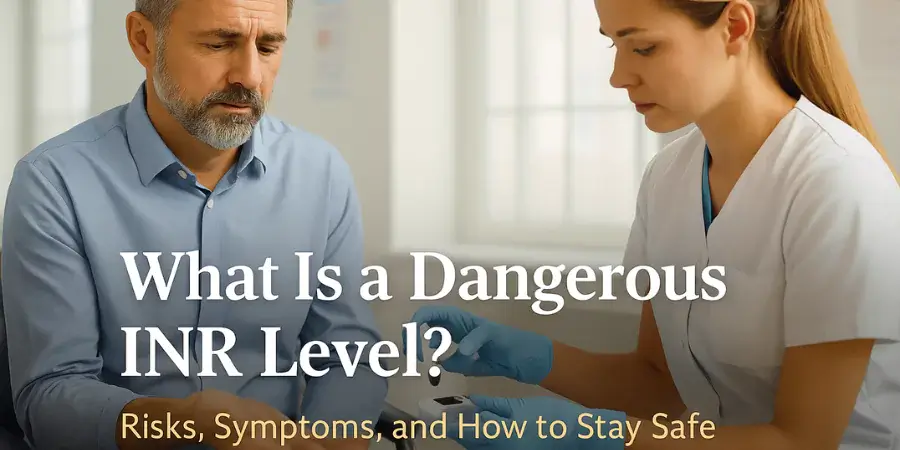Table of Contents
- Introduction
- What Is INR and Its Normal Range?
- What Is a Dangerous INR Level?
- Causes of Dangerous INR Levels
- Symptoms of Dangerous INR Levels
- How to Prevent Dangerous INR Fluctuations
- When to Seek Immediate Medical Help
- FAQs
- Conclusion
Introduction
The International Normalized Ratio (INR) is a vital measurement used to monitor how quickly blood clots, especially in individuals taking anticoagulant medications such as warfarin. Maintaining INR within a safe range is crucial—a high INR increases bleeding risk, while a low INR raises the chance of blood clots.
This guide explains what qualifies as a dangerous INR level, common causes, symptoms to watch for, and key steps to stay safe.
What Is INR and Its Normal Range?
INR is a standardized scale used to measure the time it takes for blood to clot. Ideal INR levels differ based on medical conditions and treatment plans:
- Healthy individuals: Around 1.0
- On blood thinners (e.g., warfarin): 2.0–3.0
- High-risk patients (e.g., with mechanical heart valves): 2.5–3.5
Any significant deviation from these ranges may lead to serious health risks, such as excessive bleeding or dangerous clot formation.
What Is a Dangerous INR Level?
A dangerous INR level refers to values that either:
- Increase bleeding risk (INR > 4.0)
- Heighten clotting risk (INR < 2.0)
Key Thresholds:
- INR below 2.0: Elevated risk of deep vein thrombosis (DVT), pulmonary embolism (PE), or stroke
- INR above 4.0: Significantly raises the chance of internal bleeding
- INR above 5.0: Considered critical and may require emergency treatment, including vitamin K or plasma transfusions
Causes of Dangerous INR Levels
Several factors can disrupt INR levels:
- Incorrect Warfarin Dosage
– Overdosing raises INR; underdosing lowers it, both posing risks. - Sudden Dietary Changes
– High intake of vitamin K-rich foods (e.g., spinach, kale, broccoli) can decrease INR. Low intake may increase it. - Drug Interactions
– Medications such as antibiotics, NSAIDs, and antifungals can influence warfarin’s effects. - Liver Disease
– Since the liver produces clotting factors, liver dysfunction can impact INR regulation. - Alcohol Consumption
– Excessive alcohol can increase INR, especially when combined with anticoagulants. - Illness or Infections
– Acute or chronic illnesses may cause fluctuations in INR levels.
Symptoms of Dangerous INR Levels
Signs of High INR (Bleeding Risks)
- Frequent nosebleeds
- Bleeding gums
- Easy bruising
- Blood in urine or stool
- Prolonged bleeding from cuts
- Severe headaches or unexplained dizziness
Signs of Low INR (Clotting Risks)
- Leg pain or swelling (potential DVT)
- Chest pain or shortness of breath (possible PE)
- Sudden numbness, weakness, or speech issues (stroke symptoms)
Seek medical attention immediately if any of these symptoms occur.
How to Prevent Dangerous INR Fluctuations
- Regular INR Monitoring
– Frequent testing is essential, especially while adjusting warfarin dosage. - Maintain a Consistent Diet
– Avoid sudden changes in vitamin K intake to stabilize INR levels. - Manage Medications Carefully
– Always inform your doctor before starting new medications or supplements. - Limit Alcohol Intake
– Excessive drinking can interfere with INR stability. - Know the Symptoms
– Stay informed about the signs of high or low INR to act early. - Stay Healthy and Hydrated
– Illness and dehydration can disrupt blood clotting and affect INR.
When to Seek Immediate Medical Help
Contact emergency services or your doctor right away if:
- Your INR is higher than 5.0
- You experience heavy or uncontrollable bleeding
- You show symptoms of stroke, heart attack, or embolism
Delaying treatment may lead to severe or life-threatening complications.
FAQs
What is considered a dangerously high INR level?
An INR above 4.0 is risky; over 5.0 requires immediate medical intervention.
Are low INR levels dangerous?
Yes. Low INR can lead to blood clots, increasing the risk of stroke or heart attack.
How often should INR be tested?
Typically once a week or bi-weekly for patients on warfarin, depending on stability.
Can diet impact INR?
Yes. Foods high in vitamin K can significantly alter INR readings.
Are there alternatives to warfarin?
Yes. Direct Oral Anticoagulants (DOACs) such as apixaban and rivaroxaban don’t require INR monitoring but may not be suitable for everyone.
Conclusion
Understanding what a dangerous INR level is can be crucial—especially for those taking anticoagulants like warfarin. An out-of-range INR, whether too high or too low, can lead to serious health risks including internal bleeding or blood clots.
To stay safe:
- Monitor INR regularly
- Maintain dietary consistency
- Avoid drug interactions
- Recognize early warning signs
If your INR reaches dangerous levels or you notice unusual symptoms, don’t delay—seek immediate medical help to protect your health and well-being.




